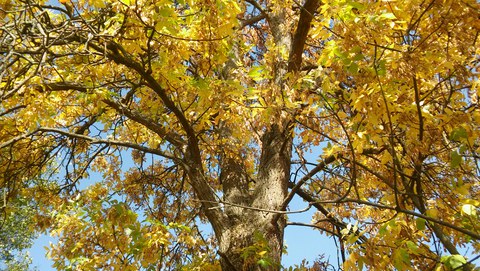Sep 09, 2021
Microhabitats and epiphyte diversity on planted green ash

green ash (Fraxinus pennsylvanica) in autumn
The non-native, North American green ash (Fraxinus pennsylvanica) is classified as invasive for near-natural habitats. However, being stress-tolerant with attractive appearance, it is increasingly planted in cities.
Within the projekt “The impact of Fraxinus pennsylvanica on the biodiversity of River Elbe and River Oder”, epiphytes (bryophytes, lichens) and microhabitats (e.g. cavities, crown deadwood) were recorded on planted green ash in the cities of Dessau-Roßlau and Dresden. Compared to indigenous common ash (Fraxinus excelsior) and common oak (Quercus robur) few differences were found in epiphyte diversity and species composition. Microhabitats are even much more diverse on green ash than on similarly sized (and putatively, older) common ash and common oak. Conclusively, the impact of green ash on epiphytic bryophytes and lichens is relatively low, while indigenous animals might even benefit from additional habitat structures in urban areas.
The use of green ash as an ornamental tree should, therefore, not generally be rejected. Nonetheless, its establishment and further spread should be monitored and eventually be managed.
The publication:
Dittrich S, Thiem E, Albrecht BM, von Oheimb G (2021). Cryptogamic epiphytes and microhabitat diversity on non-native green ash (Fraxinus pennsylvanica Marsh., Oleaceae) in urban habitats. iForest 14: 393-399. - doi: 10.3832/ifor3739-014